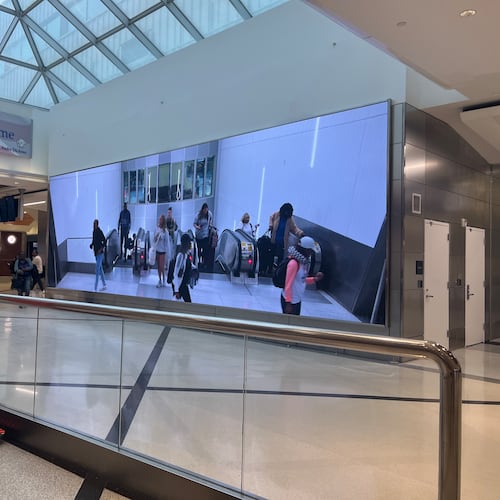A dream of driverless podcars transporting passengers in the Atlanta airport area is moving forward on the campus of the Georgia International Convention Center.
The ATL Airport Community Improvement Districts is developing a pilot that will bring Personal Rapid Transit, or PRT, to the convention center area. The group and its partners, including MARTA, Fulton County, Clayton County and College Park plan to sign a memorandum of agreement Tuesday backing the program, said Gerald McDowell, executive director of the AACIDs, a pair of self-taxing business districts that help plan infrastructure and provide services near Hartsfield-Jackson International Airport.
A PRT system would not have the capacity of alternatives such as heavy or light rail. But it would cost less per mile, proponents say. Still, there aren’t many examples of viable systems in the U.S.
The AACIDs have studied PRTs and other transit possibilities to improve mobility in the airport area since 2018. McDowell expects the project could cost $20 million to build and MARTA says it will invest an initial $1 million to get the project off the ground.
“As the region’s transit agency, MARTA is always open to exploring new, innovative modes of transit that may offer advantages to moving riders more effectively throughout the region,” a MARTA spokeswoman said. “Our FY 2024 budget includes $1 million for the feasibility study and demonstration project,” with additional funding in years to come.
The AACIDs plan to issue a request for proposals next month inviting companies to compete for a contract to build a system — but will be expected to pay for half of the expense, or roughly $10 million, McDowell said. He said he hopes to have the system operational by 2025.
The project at the GICC is expected to start small, connecting the convention center campus with the SkyTrain to the airport. But if it proves successful, it could be the start of an expansive network of autonomous transit.
Here’s how the PRT pilot project would work. Riders would use an app to request a free ride in a podcar to get from the Sky Train station at the GICC to the Gateway Center Arena in College Park. The podcars will travel on a dedicated path or guideway, supporters said.
“We’re calling it a demonstration pilot project,” McDowell said, adding the goal is to expose people to the concept to see how it is accepted, and test the system. “Let’s see if the technology works like they say it’ll work,” he said.
McDowell said changes in federal regulations over the last several years make Personal Rapid Transit technology more viable.
“But there is still a lot of reluctance,” McDowell acknowledged, in part because there are few examples of PRT systems in operation.
One of the oldest in the U.S. is a system in Morgantown, West Virginia, which dates back to the 1970s. Other systems have been built overseas, including ones at London’s Heathrow Airport, in Abu Dhabi and Korea. A PRT system is being planned for San Jose, California.
Clayton County Chairman Jeff Turner said commercial density of the area around the Gateway Center, including adjacent hotels, make the GICC a perfect test location for the PRT. He said the area’s foot traffic will provide insight into whether PRT is an efficient transit option and to whom the podcars will appeal.
“I’m excited about it and looking forward to where do we go from here,” he said.
College Park City Councilman Ambrose Clay said officials have spoken to several podcar manufacturers and most of their offerings are still unproven. He said the concept podcars he has seen usually hold around six people, are electric-charged, and can be linked together like a small subway train if that is what riders are looking for.
“This can be highly personalized,” he said. “I am very impressed by the technology.”
But none of the PRT developers that Atlanta-area officials met with have a full-fledged commercial operation in place, McDowell said.
McDowell hopes people interested in learning about PRT would fly into Hartsfield-Jackson and take the Sky Train over to the GICC to see and experience the system in operation.
Ultimately, the AACIDs envision a PRT system that would transport passengers on a route they call the Corporate Crescent between Hartsfield-Jackson’s domestic and international terminals, passing by Delta Air Lines’ headquarters, Porsche Cars North America’s headquarters and test track and other sites. A financial feasibility study on the concept is expected to be completed by the end of 2024.
McDowell also said the AACIDs will hand off responsibility for future PRT plans — such as building a larger PRT system on the Corporate Crescent route — to transit agencies.
The Latest
Featured


